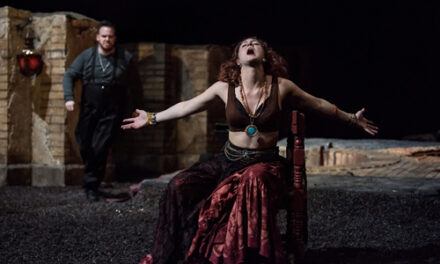This is Gerard Schwarz‘s 12th year as music director of the Eastern Music Festival, now in its 55th season. One of his imaginative innovations has been to have all the festival’s three full-sized orchestras – two all-student orchestras (usually heard on Thursday and Friday nights), and the fully professional Eastern Festival Orchestra (which is featured on Saturday nights) – play in one concert. This concert was held in Dana Auditorium on the Guilford College campus and is the perfect sampler for the amazingly high artistic standards and talent to be had at all levels of this year’s festival. This concert focused entirely on works by Wolfgang Amadeus Mozart (1756-91). Early in his conducting career, Schwarz was music director of the Mostly Mozart Festival in New York City. That depth of experience was telling in some remarkably fine performances culminating in the finest live Symphony No. 41, the “Jupiter,” I have heard.
The festival does not make the reviewer’s work easier by having long abandoned separate names for the two student orchestras. Back in the 1970s, one was called the Eastern Symphony and the other was called the Guilford Symphony.
The first student orchestra on stage played two wonderful Mozart works – the bubbly overture to the opera Le Nozze di Figaro (The Marriage of Figaro) K. 492 followed by the enchanting Concerto in C for Flute and Harp, K. 299. Schwarz divided the seating of orchestras with the violin sections split on either side of the podium. This brings extra clarity to performances of Classical period works.
Within the overture, intonation and ensemble of the student string players was very good – so essential in Mozart where errors stick out like a mustache drawn on a picture. Woodwinds and brass were fine. The playing was so infectious I regretted the curtain was not about to rise on Figaro measuring for a bed!
This high level of playing by the students was maintained as they provided substantial support for the faculty soloists in the charming Concerto for Flute and Harp. Principal flute Les Roettges has held that position with the EMF since 2002. Harpist Anna Kate Mackle was once a student at the festival and has been principal harp since 2000. Schwarz led an accompaniment that fit his soloists like a glove. Roettges had extraordinarily superb breath control and had a seemingly effortless technical mastery. What beautiful runs and trills! Mackle’s articulation and care for color and tone was superb. Her arpeggios were gorgeous. Both players excelled in the cadenzas. The pairs of student oboists and horn players were remarkably good. How lustrous was their blending with their stand mates or their pairing with the faculty soloists!
After a brief intermission to clear the stage of one student orchestra and to allow the second one to be seated, the program continued with the great Clarinet Concerto in A, K. 622 with Shannon Scott as soloist. Scott is the principal clarinet in the professional Eastern Festival Orchestra. The students of the second orchestra were at least as accomplished as those in the first, following every twist and turn of Schwarz’s stylish accompaniment. Scott’s breath control and her ability to spin out Mozart’s seamless melodies was commanding and sumptuous, not least in the blissfully unworldly second movement Adagio. I loved the full rich tone of her lower chalumeau register and her refined palette of color throughout.
After a full intermission, music lovers were treated to a really magnificent performance of Mozart’s Symphony No. 41 in C, K. 551. Finer quality instruments and lots of professional experience contributed to the polish and the seamless response of the Eastern Festival Orchestra’s players. Schwarz led the four movements with beautifully chosen tempos and consummate phrasing. Nothing dragged or seemed in the least bit rushed. Orchestra balance was perfect and his seating of string players helped add to the clarity of musical lines. Each movement was a perfect gem, not least the contrapuntal high jinx of the finale.











